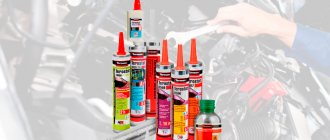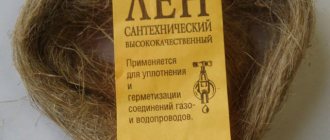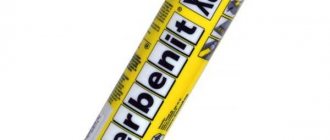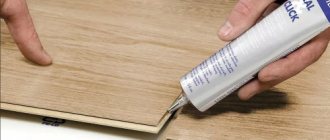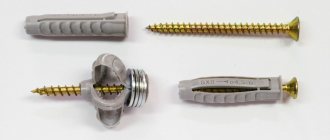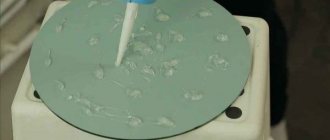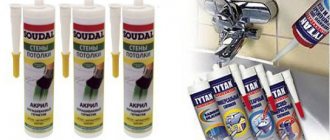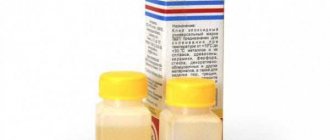When one or another type of material is used for the roofing of buildings (slate, bitumen, tiles, rolls, metal tiles or corrugated sheets), there is a need to seal overlaps, joints and gaps, as well as fastening points.
This allows not only to protect the surface from moisture penetration, but also to provide thermal insulation, and the metal elements of the roof will be protected from corrosion.
Under-roof protection is provided by special films or insulation, but sealing is carried out using seals, tapes or sealants.
Why are roofing sealants needed?
Sealants can be used both as a building material and as a repair agent for roof maintenance.
Using this material you can carry out the following roofing work:
- Seal seams between individual roofing elements. Most often, this is needed on roofs with a small slope angle.
- Seal joints in areas where the roofing material comes into contact with other coverings.
- Eliminate cracks in the area of chimney ducts, drainpipes, ventilation shafts, communications and other elements that cause a violation of the integrity of the roofing covering.
- Treat skates located on a slope.
- Prevent cold bridges.
- Carry out quick sealing of leaks.
The most popular are six types of roofing sealants
CONCLUSIONS
- Sealant is a special substance to ensure the tightness of the roof covering, joints, and connections.
- The main qualities of the material are strength, reliability, moisture and air tightness.
- There are 4 main types of sealants: silicone, bitumen, acrylic, polyurethane.
- Each type of sealant has its pros and cons.
- To obtain a good result, sealing must be carried out according to all rules.
- Prices for sealants depend on the specific type of substance, technical characteristics, and manufacturer.
Video instructions on how to carefully fill the seams with sealant.
Sealing tapes
An inexpensive and effective means of roof protection. This material withstands low temperatures and exposure to the sun. It is very easy to install, and just as easy and quick to remove if replacement is necessary. The bitumen layer created in this way is characterized by good thickness and tightness. It is very resistant to mechanical stress and has good durability.
The tape is often used as a repair patch on bitumen roofing. With its help, it is convenient to insulate junctions, seal vapor barrier material, and repair seam metal roofs and drainage systems. The use of sealing tape is especially suitable for those new to roofing work. It is used to waterproof seams and joining areas. In application, the tape is very similar to regular tape.
Purpose
Bituminous material is used for many types of work related to the construction, processing and repair of roofs. It is a universal product that is used for sealing small holes, sealing cracks, and waterproofing roofs.
The main areas of use of bitumen sheets:
- construction and repair of the roof, including processing of corner parts and ridge;
- protection against rust of metal elements;
- muffling extraneous noise created by electrical or mechanical devices;
- insulation of joint and seam areas of various areas of the roof (the gap between the roof and the chimney, cracks in brickwork);
- production of floors;
- sealing window and door openings;
- insulation of foundations of small areas and sewer reinforced concrete structures.
Bitumen tape is available in different sizes and is packaged in rolls. This makes it easier to select the parameters of the canvas for any specific case.
Bitumen sealant
Metal roofs made of corrugated sheets, metal tiles, etc. are most often sealed using bitumen sealant. The material can also be used on tiled and roofing felt roofs. Bitumen sealant for roofing is quite toxic and not very resistant to high temperatures (read: “Types of roofing bitumen sealants, rules of use, methods of application”).
As for the strengths of this rather elastic sealant, it is first of all worth highlighting its high strength and moisture-resistant characteristics. Bitumen sealants can be laid not only on dry, but also on wet substrates, with the possibility of subsequent painting to match the overall coating.
Product brands
When choosing a sealant, it is better to choose a high-quality option from a reputable manufacturer. The most famous brands of bitumen sealants are:
- TechnoNIKOL.
- Moment.
- Titanium.
- Makroflex professional.
- Soudal.
- Germent and others.
Sealing joints and gaps is a very important stage in the installation of roofing. service life of your roof depend on it . Bitumen sealants are an excellent sealing product, which you need to choose correctly and know how to handle it.
Rubber and silicone
For the sale of silicone mixtures, both standard packaging for pistols and buckets can be used, which makes it possible to apply the substance with modern spray guns and construction rollers. Roofing silicone is one of the most popular materials of this type.
The fact is that this universal material is not afraid of significant fluctuations in air temperature and direct sunlight. Once applied, silicone roofing sealant hardens quickly. It is used for both temporary and permanent purposes. Silicone-type compounds can be acetic or neutral. The latter option is not as durable as the first, but does not emit toxic substances and is practically odorless.
Sealing seams
The seams between the chimney and the roof surface are sealed in a certain way. First, it is necessary to treat the surface on which the bitumen sheet is to be glued. To work with concrete coating, you need to use an electric grinding device paired with a vacuum cleaner. After cleaning, the surface must be rid of the fat layer.
You will need certain tools: a lapping roller, a knife, scissors, rags for wiping accessories and hands during work. Before sealing the joint of a flat-coated pipe, a bitumen strip is wrapped around the pipe to determine the required length of the piece. A mark is made at the required place on the canvas, along which the required size of the tape is cut. The result will be a length that is sufficient to seal the seam.
On the lower part of the canvas, cuts are made in several places with scissors for distribution along the roof plane. Then the protective material is removed from the cut piece of fabric. The tape, ready for use, is applied to the required area, the cut area is glued to the roof surface. It is important not to forget about the formation of bubbles from the air and disperse them in a timely manner. The area glued to the pipe is rubbed well with a roller. In the area of the slots, which is located on the roof plane, auxiliary patches cut from the same material are applied. They are also pressed with a roller.
For more information on sealing chimney seams, see below.
Installation of PVC windows- Covering the drain hole with your own hands
- How to lay flexible tiles on the roof?
Acrylic
This type of sealant is very similar to the previous one, at a lower cost. In addition, to apply it, the surface to be treated must be thoroughly dried. The advantages of the material include the complete absence of solvents and odor during use.
If you want to achieve maximum invisibility of the treated area, this will be quite easy, thanks to the significant color range of acrylic sealant. When using this material for roofing work, one should take into account its low waterproofing characteristics. This is explained by the presence of aqueous dispersion in the acrylic composition. To solve this problem, it is recommended to use joint tape in parallel with acrylic sealant.
Application in repair
Bituminous material is excellent for sealing defects in the roof. In such work it is necessary to follow the sequence of actions.
- The area of the roof in the area of installation work is thoroughly cleaned of dirt using a bitumen sheet. This area can be washed with water, dried, then degreased.
- Having removed the protective film, the tape is glued to the seam of the two roofing elements, starting from the beginning of the roof. The edges of the canvas are rubbed.
- The bituminous material is gradually pressed down as work progresses with a roller. In the case of joining pieces of tape, you need to make an overlap, which should be at least 1.5 cm. When doing this work, it is better to resort to the help of a partner, then the result will be smoother and more accurate.
In the same way, all seams are laid between individual parts of the roofing material. Fixing flaws in the roof is done in a similar way.
Polyurethane
Polyurethane sealant is based on polymerized resins, the production of which will require special conditions. The result is a viscous and fluid substance that can be easily processed on any surface.
This type of sealant is quite toxic and the most expensive: the cost of purchasing it is fully compensated by the high performance characteristics of the material. In this case, sealing can be carried out in fairly severe frosts; The substance is easy to apply and hardens quickly. The resulting surface effectively serves for a long time, withstanding mechanical stress, moisture and corrosion. Any substrate is suitable for applying polyurethane sealant.
Material characteristics
The sealant is a special substance of a viscous, paste-like and fluid consistency, made on the basis of organosilicon and polysulfide liquid rubbers and polymers. It is used to ensure the tightness of various joints and connections. The substance is applied to bolts, rivets, and other connections.
Find out more about how to install a soft roof with your own hands.
What are the features of the valley rafter system can be found here
Sealant is a new generation material. Its distinctive qualities are strength, reliability, and elasticity. Important advantages of this substance are its moisture and air resistance. The choice of a specific sealant depends on the type of surface on which it will be used.
The substance retains its physical properties over a fairly wide temperature range: from minus 55 to plus 80 degrees.
Two-component
The two-component mixture is based on silicone rubber, the ingredients of which are adhesive paste and a special hardener. The shelf life of this sealant until the moment of application is quite significant, however, after mixing the individual components, the sealant must be applied within a certain time, otherwise the polymerization process will begin.
The two-component composition is quite convenient to apply, and this can be done at temperatures from -25 to +40 degrees. As for the temperature stability after the substance hardens, it ranges from -70 to +70 degrees. Rubber roofing sealant adheres well to metal, concrete, plastic, brick surfaces, and the resulting seam after sealing is characterized by strength and smoothness.
Tips for choosing
Conventionally, all the given materials are divided into universal and specialized. Possible situations and recommended sealing options are shown in the table:
| Possible problem, type of coating or design | Optimal view |
| Insulation of openings and areas adjacent to chimneys, ventilation shafts, fences and roof windows | Reinforced tape |
| Construction of a metal roof | Bituminous |
| Formation of small cracks in the Ondulin coating | Silicone |
| Sealing of ridges and seam units | Ribbon |
| Connecting moving and vibration-prone seams | Acrylic and silicone stamps |
| Need for quick repairs | Polyurethane |
| Construction of a roof with a small slope and a large number of overlaps | All types listed, double sided tape, sealing cords |
| The need for sealing and gluing of soft roofs | Bitumen mastic |
Price
| Brand name, manufacturer | Type of base, type of sealant, consistency | Application temperature/temperature resistance °C | Packaging, ml | Price, rubles |
| Soudal Aquafix colorless, Belgium | Stable one-component paste based on acrylic copolymers with shrinkage up to 30% | +5 to +30/-20 to +90 | 310 | 460 |
| Tytan Professional colorless, Poland | Elastic sealant based on rubber | +5 to +40/-55 to +100 | 285 | |
| Tytan Industry, Poland | Professional polyurethane composition | +5 to +35/-55 to +100 | 600 | 340 |
| Penosil All Weather, Estonia | Colorless, based on synthetic rubber, frost-resistant | -5 to +40/-40 to +80 | 310 | 210 |
| Penosil Premium Bitum Sealant, Estonia | Bituminous | +5 to +30/-40 to +110 | 190 | |
| Makroflex black, Estonia | Thixotropic bitumen mass | +5 to +30/-30 to +80 | 290 | 200 |
| Ecobit 100 mm green, Italy | Self-adhesive bitumen-polymer tape | -5 to +30/-40 to +80 | 100 m | 1400 |
| Sazilast 51 | Two-component polysulfide thiokol sealant for corrugated roofing | 15 to +40/from -60 to +90 | 14+1.4 kg | 4700 |
Mastic
Along with the above sealants, the roof can also be treated with mastic. To produce this viscous plastic mass, you will need to mix binders and fine fillers such as carbon black, talc, graphite, etc.
The material also contains special additives. By dosing different components when mixing, you can give the substance the required characteristics. Waterproofing is mainly carried out with bitumen mastic, however, if we are talking about the installation of roll materials, a more expensive polymer version can also be used.
Peculiarities
Dealing with bitumen strip is quite easy: no specific experience is required. But there are some nuances. For example, it is not recommended to place the canvas on an untreated surface, since a situation arises in which it will not stick or will last a short time. Processing consists of carefully cleaning the prepared materials from excess substances.
To achieve the best effect, various devices and electrical appliances are used. It is important to remove oily areas, if any. To do this, special tools are used. After cleaning, they must be allowed to dry thoroughly. Then the old processing must be removed, if it existed. You can do this with improvised means, removing residues with a solvent.
Installation of ventilation systems- Pipes for internal sewerage
How to choose a window sill?
When working with adhesive strips, it is better to use a lapping roller. Using it you can get rid of air bubbles, which in some cases form under the canvas during the installation of construction tape. Remaining air bags damage the seal and shorten the useful life of the tape. In some cases, pieces more than 1.5 cm wide can be overlapped. In such situations, moisture will not leak in, and the tightness of the butt joint will be maintained.
If the bitumen tape has been lying in a cool place for a long time, the material must be warmed to room temperature before using it.
Metal roofing
It is best to seal a metal roof with a material that has the following properties:
- Elasticity.
- Resistant to precipitation.
- Good adhesion to metal surfaces.
- Ability to withstand vibration well.
Having carefully studied the question of which sealant to choose for corrugated sheets, you can come to the conclusion that polyurethane and bitumen-rubber type substances are most suitable in this case. The metal surface, before applying them, must be thoroughly cleaned, dried and degreased.
In case of urgent repairs, a metal roof sealant is selected that can be applied to a wet base. Corrugated sheeting and metal tiles have similar characteristics, so the process of sealing them is identical. In addition, roofing sealants for corrugated sheets can be successfully used on other types of metal roofs.
In order for the sealing of a corrugated roof to be reliable and durable, the following procedures should be carried out:
- Carefully check all joints before applying sealant. If necessary, clean and dry them.
- To apply sealant to a corrugated roof, an even layer of 2-3 mm is used. In this case, polyurethane tape will not be superfluous.
- The work must be carried out in dry, warm weather, since sealant for roofing with corrugated sheets does not react well to humidity.
Regarding the application of sealant to metal roofing, the following recommendations will be required:
- Gaps up to 5 mm are sealed with silicone sealant. For this purpose, a composition is selected that tolerates sunlight well.
- All roofing joints need to be treated, both longitudinal and transverse. It is also important not to forget to seal the ventilation duct, antenna outlet and chimney.
Terms of use
Since the product is flammable, you must follow fire safety rules and avoid getting the composition on your skin. And don't forget to wear protective gloves. The composition can be applied using a construction gun, and it is leveled using a spatula dipped in soapy water.
Sealants are removed after work using white spirit, and if they have hardened, then only mechanically. For this reason, all surfaces and tools should be cleaned with solvent immediately after sealing is completed.
Before work, you need to properly prepare the surface. It should be cleaned of dirt:
- dust is cleaned mechanically or using compressed air;
- oil and fat - using solvents;
- The hardened sealant is removed with sharp tools.
Next comes work with the cartridge. It is cut off above the thread and the spout is screwed on. It needs to be cut diagonally so that the hole is equal to the width of the joint or gap. The cartridge is then placed into the construction gun.
Sealant is applied to the edges of the surfaces to be glued in strips or dots. If deep seams, holes or joints are filled, then it is applied in layers , each time allowing the previous layer to dry. And if the gaps are wide, then you need to put a polypropylene cord between the two layers.
If the composition is applied in large volumes, you will additionally need a trowel and a spatula, with which it can be easily collected from a jar or bucket. It is necessary that the corners of the tools are rounded and the working substance does not stick; to do this, they are moistened with a soap solution.
You also need to calculate the sealant consumption before work. So, 1 ml of product is required to fill 1 cubic centimeter. To determine the volume of the seam, you need to multiply its length, width and depth by each other. For example, to fill a seam one meter long and 10 mm wide and deep, you will need 10 ml of product. Add another 30 percent to the resulting figure, since the sealant cannot be applied flush.
The maximum permissible seam size is 30 mm wide. It is very important to follow the “two depths” rule, according to which the width should not be more than half the depth. The deeper the seam, the longer the sealant will take to harden.
Soft roof
Global sealing of soft roofs is mainly carried out using mastic.
In other situations, the following sealants are used for membrane roofing:
- Flat roofs are sealed with liquid rubber.
- It is convenient to carry out fragmentary repairs with one-component liquid rubber.
- Seams and joints can be sealed with sealing tape or roof joint sealant.
- Even wet substrates can be treated with sealing mastic. This material is characterized by strong adhesion to basic building materials.
Roof types
There are two main types of roofs in shape - flat and pitched.
In private construction, pitched roofs are the most widespread because water does not accumulate on them, and thus leaks are minimized. However, flat roofs have a significant advantage - they allow more efficient use of space, and reliable sealing should be ensured on any type of roof.
Important!
SP 17.13330.2017 “Roofs. The updated version states that reducing the roof slope entails the need to provide additional measures to ensure its waterproofness: the use of under-roofing film, sealing joints with non-hardening sealant or sealing tape.
Roofs are also distinguished by the materials from which they are made.
Main types of roofs:
- mastic bitumen or polymer;
- roll welded and glued;
- made of piece materials (tiles, slate, polycarbonate, metal profiles).
Buyer Information
- ✔ Information on size, weight, prices, photos and other characteristics in the product catalog will help you choose and buy self-adhesive waterproofing tape in the online store.
- ✔ Delivery in Moscow and the region is carried out by vehicles with a carrying capacity from 500 kg to 10 tons. Detailed information about the service, conditions and cost can be found on this page.
- ✔ We sell self-adhesive tape for waterproofing wholesale and retail. At the same time, retail customers can apply for a Petrovich Friends Club card, receive discounts and accumulate points.
By continuing to work with the site, you consent to the site's use of cookies and the processing of personal data for the purposes of site operation, retargeting, statistical research, service improvement and provision of relevant advertising information based on your preferences and interests.
